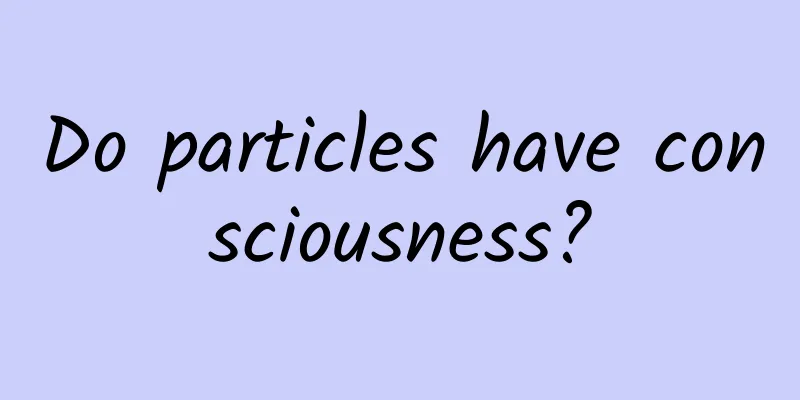Do particles have consciousness?

|
Although we are talking about the smallest substance in the world - particles, this topic involves a very wide range of knowledge, including philosophy, life science, biology, classical physics, quantum mechanics, chemistry and many other disciplines, and no single discipline can explain this issue clearly. So why do particles themselves have no consciousness, but when a bunch of particles are combined into a human, they will have consciousness? I don’t expect to explain it clearly, but I can try to analyze it and discuss and share it with netizens, just to start a discussion. First, we need to give consciousness a personality In textbooks or encyclopedias, consciousness is a unique function of human beings. It is a reflection of the objective world. It is constrained by the material world, but it will react to the material world. This is a philosophical explanation. To put it simply, consciousness is a unique function of human beings that has emerged in the long-term evolution. Only when human beings have consciousness can they become smarter and thus become the masters of the earth. Specifically, human consciousness is a complex consciousness, which means that one can accumulate and pass on one's own experience and knowledge through memory and logical (abstract) thinking. The basis of memory and logical thinking is self-awareness, which is the ability to know oneself and to distinguish oneself from other individuals, including other humans and various objects. In addition to humans, some animals also have simple self-awareness. Scientists have a classic test method to distinguish these animals, which is the so-called mirror test. Although this test is controversial, there seems to be no better way to verify whether animals have self-awareness. This method is to test whether the animal knows that the image in the mirror is itself by looking in the mirror. More than ten kinds of animals, including elephants, gorillas, dolphins, and crows, have passed this experiment. Unfortunately, dogs and cats, which humans think are very smart and their most loyal friends, have not passed this test. Of course, the self-awareness of these animals tested in the experiment is also vague and simple. Therefore, although they appear to be smarter than other animals, they are still unable to form logical thinking and memory. Otherwise, humans would be in danger and their dominant position would be shaky. I have said many times that this is because the biggest difference between animals and humans is that animals have not formed complex language and time concepts, which are basic tools for thinking and memory. Without these tools, the stimulation of the material world can only remain in the form of images, and it is impossible to form abstract thinking and memory with marks. For example, if we see a table, a car, and a group of people drinking in a certain period of time, we will form concepts such as table, car, people, wine, and events in our minds, and mark them with time to form abstract thinking and memory. We can try to think about it. If there are no language cells, concepts and time markers, can you connect the things you see and experience, and form memories and abstract thinking? So, it is true that consciousness is a unique function of humans, but primary consciousness or simple consciousness is not unique to humans. Next, let’s understand whether individual particles have consciousness. The proposition is "a single particle is unconscious, but a bunch of particles combined together have consciousness", so is this really the case? Particles are the name people give to the most basic units that make up matter. Since some particles have internal structures, the term "elementary particles" is no longer used. Modern physics divides particles into three categories: quarks, leptons, and propagators, including six types of quarks, three types of charged leptons, and three types of neutrinos. All particles have antiparticles, including positive and negative particles, which are 62 in total. There are 12 leptons, 36 quarks, 14 gauge bosons, etc. I won't go into detail. So is a single particle really unconscious? This seems to be a question worth exploring. Research in quantum mechanics shows that all particles have wave-particle duality, that is, they have both the properties of waves and the properties of particles. The most famous experiment to verify this theory is the double-slit interference effect experiment. Some people call this experiment a weird experiment that is scary and frightening. Why is that? What is light? Is it a particle or a wave? This question has been debated in the scientific community for hundreds of years until 1704, when Newton published the book Opticks, which defined light as a particle. Because he was a scientific giant and no one could afford to offend him, the debate seemed to have come to an end. But with the development of science, people opened the door to subatomic matter, and the controversy arose again. In 1801, British physicist Thomas Young conducted a double-slit interference experiment on light. The light passing through the two slits left interference fringes on the background, which is the nature of waves. As a result, people denied Newton's particle theory of light and seemed to have finally determined that light is a wave. However, with the deepening of scientific research, the wave theory of light cannot explain many mysterious phenomena, such as blackbody radiation and the photoelectric effect. 100 years later, Einstein, Planck and other founders of quantum mechanics rediscovered the particle theory of light and demonstrated that light has both wave and particle properties. Thus, the wave-particle duality theory of light quanta was officially introduced and became the founding theory of quantum mechanics. In 1961, Klaus Jonsson of the University of Tübingen in Germany had a sudden idea after eating and conducted a shocking experiment, which revealed the strange Pandora's box of the particle world. The experiment was not unusual at first, and it was still to let photons pass through double slits to leave interference fringes on the background. At the same time, it was also found that electrons and molecules also have this phenomenon, which shows that wave-particle duality is a common property of all particles. But when Jonsson tested the emission of a single photon or a single other particle, interference fringes were still left, which was puzzling. This is like firing a machine gun and a rifle separately. The bullets fired by the machine gun may pass through the two slits, but the rifle fires one by one, so logically each photon can only selectively pass through one slit. The result was not like this. Even a single light was split into two halves like a bullet, and shot from the two slits to the background behind, forming interference fringes. Can particles really split into two? Jonsson installed a detection device on the path of the particle passing through the double slits, hoping to find out how a particle can pass through both slits at the same time and leave interference fringes behind. As a result, a miracle happened: the interference fringes behind disappeared! But after turning off the detection device, the interference fringes reappeared! What is even more bizarre is that scientists later conducted a more in-depth experiment, which is the more shocking double-slit interference delayed detection experiment. This experiment placed the detector after the double slit and set it to detect only after the particle has passed through the double slit. According to logical inference, the particle has passed through the double slit, and its path has been formed and will not change the result, but these particles seem to know in advance that someone is going to detect it. There is still no interference pattern when detecting, but there is interference pattern when not detecting! Later, scientists conducted a further experiment to erase the particle path. When the detection device was turned on, no interference fringes were formed. After the experiment, the experimenter erased the path information. The result was shocking. The interference fringes reappeared! This means that the results that have been formed can also be changed. Making some changes now can actually change the past! Can particles have consciousness? Can the one-dimensional forwardness of time also be changed? The mechanism here has left scientists scratching their heads and puzzled, and it remains a mystery to this day. This is why the results of the double-slit interference experiment are so frightening. However, this strange characteristic of the particle world has become the foothold of quantum mechanics theory. From this, theories such as the quantum uncertainty principle, quantum entanglement, Schrödinger's cat, and wave function collapse have been developed, all of which have become the orthodox mainstream theories of quantum mechanics. What can we learn from these experiments? Do particles really have consciousness? This consciousness is certainly not the advanced consciousness of humans, but can only be said to be the basic characteristics or instincts of particles. So is it because of these characteristics and instincts that a bunch of particles can generate consciousness when they are gathered together? If there were no such characteristics, would we still exist in this world? This question is left for everyone to think about and discuss. Can a group of particles combined together have consciousness? Of course not necessarily. All matter in our world, including the sun, moon, mountains, rivers, lakes, seas, birds and beasts, viruses and bacteria, ants and insects, flowers and trees, etc., are composed of piles of particles, and none of them has formed the consciousness of humans. This shows that it is not the combination of a bunch of particles that will produce consciousness. In the world we know, all matter is made up of elements. So far, there are 118 elements known to humans. An element is a substance composed of a single atom. A substance composed of multiple atoms is a compound. In theory, the 118 elements can form countless compounds. People divide compounds into four major categories, namely organic compounds, inorganic compounds, ionic compounds, covalent compounds, etc. There are more than 60 elements that make up the human body, of which 11 elements such as calcium, sodium, potassium, magnesium, carbon, hydrogen, oxygen, sulfur, nitrogen, phosphorus, and chlorine are essential elements. There are also more than a dozen essential trace elements such as iron, copper, zinc, manganese, cobalt, vanadium, chromium, molybdenum, selenium, and iodine. Among them, calcium, sodium, potassium, and magnesium account for more than 99% of the total metal ions in the human body and are very important. All elements are made up of atoms, and atoms are made up of nuclei and electrons, nuclei are made up of neutrons and protons, and neutrons and protons are made up of quarks. It can be seen that the particles that make up the human body are the same as any other matter, and there is nothing special about them. So, why can humans have consciousness? I think it has something to do with the composition and operation of these particles. After billions of years of evolution, these particles have formed exquisite structures in the human body that produce consciousness, such as the brain and neural structures, including hundreds of billions of nerve cells and trillions of synapses. A complex set of operating modes is formed in these fine structures. Through the stimulation of external electromagnetic signals and the operation of internal bioelectricity, a unique and advanced consciousness is generated, which is constantly strengthened and improved in practice. Research has shown that human self-awareness is inherited from genes, but it needs to be cultivated and strengthened after birth, because infants will not develop self-awareness until about 18 months old, and the consciousness of a person who is separated from human group activities will be greatly restricted and damaged, such as the wolf boy. In short, everything in the world is made up of particles. Some combinations of particles produce consciousness, while others do not. The mechanism is very profound and complex. Modern science has only scratched the surface of the human brain and consciousness, so as a popular science article, I cannot make any academic discussion here, and can only scratch the surface. Let's stop here. This is just my personal opinion. Discussion and criticism are welcome. Thank you for reading. The copyright of Space-Time Communication is original. Infringement and plagiarism are unethical behavior. Please understand and cooperate. |
<<: How important is it to hold on to "Chinese seeds" to our country's food security?
>>: Microalgae: Eats carbon dioxide and spits out bio-oil
Recommend
Exclusive interview: An article that helps you truly understand DSP advertising
Although DSP and information flow have been aroun...
Are fruits and vegetables tastier now than they used to be? It’s not your illusion, science proves it
When you look at the rows of brightly colored fru...
Where does the poop on the plane go?
This issue is planned by: Doraemon, Little Dandel...
Virtual Reality to Reach $30 Billion by 2020
According to a recent report from Digi-Capital, t...
Vegetables have different colors and different nutrients! Some even have "special nutrients"! The ones you should eat more of are...
Meat is delicious, but without vegetables, you ma...
Pinduoduo platform operation and promotion strategy!
There is no doubt that price is Pinduoduo's a...
How much does it cost to attract investment for the Fuzhou Meat and Poultry Mini Program? What is the investment price for Fuzhou Meat and Poultry Mini Program?
Starting a business requires costs, and mini prog...
Chase the "light" during the New Year! 2025 may continue to explode, the hardcore truth is...
During this Spring Festival holiday, many young p...
Earthquakes are frequent around the world. Has the Earth entered a "vibration mode"? No! It is lower than the annual average since 1900
According to public media reports, on the first d...
Java vs. Node.js: An Epic Battle
[[160272]] Image source: Photo by Flickr user Tsu...
Online Event Promotion Implementation Manual
What is event operation? My understanding of even...
In the AI era, will APP operations be eliminated?
As early as August 8, the official account of Chi...
Short video editing course, how much does a short video editing training course cost?
Short videos have brought a large number of fans ...
The U.S. Army's key project, the Integrated Visual Augmentation System, a key part of the future warrior, has been suspended
According to reports from foreign military websit...
New Year's tips for beginners in programming
[[161291]] 1. When will I be able to finish learn...









